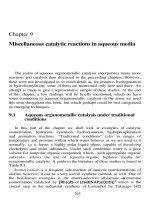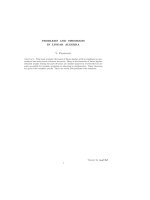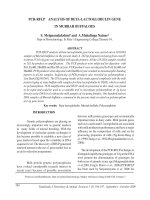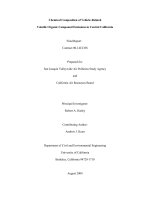Red lead: understanding red lead in leadÀacid batteries pdf
Bạn đang xem bản rút gọn của tài liệu. Xem và tải ngay bản đầy đủ của tài liệu tại đây (366.53 KB, 7 trang )
Red lead: understanding red lead in leadÀacid batteries
J.P. McKinley
a,*
, M.K. Dlaska
a
, R. Batson
b,1
a
Eagle Oxide Services, 5677 West 73rd Street, Indianapolis, IN 46278, USA
b
Clear Science Inc., 2010 E. Hennepin Avenue, Suite 201, Minneapolis, MN 55413, USA
Received 21 August 2001; received in revised form 7 November 2001; accepted 8 November 2001
Abstract
The use of red lead in battery plates is not very well known to a large segment of the lead–acid battery industry. Historically, it was used in
pasted and tubular positive plates in order to improve their formation time and enhance deep-cycle performance. Although the use of red lead
has diminished over the last few decades, many companies are again considering the use of red lead in their plates. This article aims to give
manufacturers a solid knowledge of the properties of red lead, including production and handling methods. Further, it presents an
understanding of the influence in battery production, battery performance, and the cost-saving potential of red lead usage. The first part of the
article is intended to explain the chemical and physical properties and fields of usage of red lead. The most widely used red lead product
specifications for the battery industry are presented and explained. In the second part, the typical equipment for the production of red lead is
reviewed. Raw material requirements, material handling equipment, a red lead furnace and milling are presented and discussed. The reader is
taken through the production of a typical batch of red lead. Operating charts, process control data and system photos will help to understand
the production process. The final part outlines an overall view of process requirements and identifies stages in lead–acid battery production
that will be influenced by the use of red lead. # 2002 Elsevier Science B.V. All rights reserved.
Keywords: Charging efficiency; Formation; Furnace; Lead–acid battery; Red lead; Reserve capacity
1. Chemical and physical properties of red lead
Red lead (Pb
3
O
4
), also known as minimum, trileadtetr-
oxide or lead orthoplumbate, is normally a fine, dry, brilliant
red colored solid usually used in the form of a powder. It can
also be wetted and agglomerated into pellets. In contrast to
other lead oxides, the lead atoms in red lead occur in two
different oxidation states, i.e. Pb(II) and Pb(IV). Together
with oxygen, they are arranged in a tetragonal/pseudo-
Brookite type of ionic lattice (Fig. 1) [1].
Red lead is sometimes confused with the tetragonal form
of leady oxide (a-PbO), which also has a red color, but
actually is the raw material for the production of red lead.
Red lead forms through an oxidation process when a -PbO is
heated to around 450–500 8C, but decomposes to yellow
litharge (b-PbO, orthorombic) when temperatures exceed
500 8C at atmospheric pressure, i.e.
3a-PbO þ
1
2
O
2
! Pb
3
O
4
@ 3b-PbO þ
1
2
O
2
(1)
The process of converting lead oxide to red lead can be
stopped at nearly any percent of oxidation, but industrially
three qualities are common.
Red lead of 25 and 75% are mainly used in lead–acid
batteries, especially in stationary and traction batteries;
red lead is also used in tubular plate batteries (see Tables 1
and 2).
Red lead of 85, 97 and 98% (pigment grade) are used in
protective paints but today’s main applications are crystal
glass, television tubes and glazes (see Table 3).
It is important to note that there are two common practices
to characterize red lead. One gives the combined weight
percentage of PbO
2
and PbO, while the other uses the PbO
2
amount only. Either way, the analysis is usually done with a
wet chemical method or physically by X-ray defraction (see
Table 4).
2. Production of red lead
2.1. Process steps
The most common method of red lead production is by a
two-stage process. First, leady oxide is produced either by a
Journal of Power Sources 107 (2002) 180–186
*
Corresponding author. Tel.: þ1-317-290-8485; fax: þ1-317-290-8766.
URL: www.eagleoxide.com.
E-mail addresses: (J.P. McKinley),
(R. Batson).
1
Tel.: þ1-612-270-9461.
0378-7753/02/$ – see front matter # 2002 Elsevier Science B.V. All rights reserved.
PII: S 0378-7753(01)01003-5
Barton-pot or ball-mill process. In the second step, the leady
oxide is oxidized further to red lead inside an oxidation
device, most commonly a furnace. After the desired percen-
tage of red lead has been reached, it is discharged and ground
in a low-impact hammer mill to adjust final material spe-
cifications in particle size, particle-size distribution, acid
absorption, and apparent density (see Fig. 2).
2.2. Raw material
Historically, yellow litharge (100% b-PbO, 0% Pb) was
the raw material for the red lead production. Today, most
industrial manufacturers of red lead use leady oxide as feed
material. The free-lead content of the feed material can
range from 5 to 30%, which makes the production equip-
ment for red lead an ideal solution for out-of-specification
material from Barton-pots or ball-mills.
2.3. The red lead furnace
Different equipment for the production of red lead has
been developed and used over the years. Nearly all of it has
incorporated the same basic principle of an oxidation pro-
cess that requires lead oxide, oxygen, temperature, and time.
One of the most widely used devices is the furnace, either
gas or electrically heated. The following description outlines
the operation of the electrically heated red lead furnace
produced by eagle oxide.
The electrical red lead furnace is a refractory-lined batch
oven with a totally enclosed reaction chamber (Fig. 3). It has
a vertical drive shaft that supports and turns agitator arms to
stir the batch lying on top of a furnace pan. The batch
temperature is controlled by electric heating elements
Fig. 1. Crystal structure of red lead [1].
Table 1
Physical and chemical red lead data [1,2]
Characteristics
Molecular weight 685.57
Color Brick red/orange
Crystal structure Tetragonal/pseudo-Brookite
Density 9.1 g cm
À3
Melting point 500 8C
Mohs hardness 2–3
Water solubility 6.86 Â 10
À9
gl
À1
Dielectric constant 20
Electrical conductivity $10
À12
O
À1
cm
À1
Table 2
Battery grade red lead specifications [2]
Properties Pb
3
O
4
Pb
3
O
4
(wt.%) 25 75
PbO (a þ b) (wt.%) 75 25
Pb (wt.%) 2.5 maximum 0.5 maximum
Acid absorption (mg g
À1
) 170À200 200À230
Apparent density (g cm
À3
) 1.2À1.5 1À1.2
Median particle size (mm) 3.0 2.0
Table 3
Pigment grade red lead specifications
Properties Pb
3
O
4
pigment grade
Pb
3
O
4
(wt.%) 85, 97, 98
Color Brick red/orange
Apparent density (g cm
À3
) 0.9À1.2
Median particle size (mm) 2.0
Table 4
Different red lead characterization
Pb
3
O
4
(%)
a
PbO
2
(%)
b
Pb
3
O
4
(%) PbO
2
(%)
5.0 1.7 55.0 19.1
10.0 3.5 60.0 20.9
15.0 5.2 65.0 22.6
20.0 7.0 70.0 24.4
25.0 8.7 75.0 26.1
30.0 10.4 80.0 27.8
35.0 12.2 85.0 29.6
40.0 13.9 90.0 31.3
45.0 15.7 95.0 33.1
50.0 17.4 100.0 34.8
a
Total amount of red lead in mixture (wt.%).
b
Amount of PbO
2
only (wt.%).
Fig. 2. Schematic of red lead production process.
J.P. McKinley et al. / Journal of Power Sources 107 (2002) 180–186 181
located below the reaction chamber, mostly used during the
pre-heat stage of the process. The raw material is introduced
through the sidewall or the top of the furnace by a screw
conveyor. Temperature control inside the furnace is accom-
plished by an actuated butterfly valve in the exhaust stack.
The furnace is under negative pressure during operation.
2.4. The four-step production process
The operation of the red lead furnace is a batch process
that is divided into four sub-processes.
2.4.1. Pre-heat
Before the first batch, the furnace must be pre-heated to
operating temperature. This is accomplished with electrical
heating elements. Once a batch of leady oxide is inside the
furnace, the output of the heating elements is greatly reduced
(or off), because the exothermic reaction generated by the
oxidation of Pb to PbO supplies sufficient heat for the
oxidation process. After discharging the finished product,
the efficiency of the furnace design allows the pre-heat time
to be less than 2 min between batches.
2.4.2. Furnace charging
Leady oxide is charged into the furnace by a screw
conveyor at an adjustable feed rate so that a constant heat
rate is produced by the exothermic conversion of free-lead.
High reaction temperatures favor b-PbO formation, there-
fore, it is important to avoid these conditions in order to
maintain a satisfactory production rate. Since the feed
material is introduced into the furnace at ambient tempera-
ture, the reaction temperature at the beginning of the batch
decreases (see Fig. 4). During this period the heating ele-
ments keep the furnace pan hot in order to bring the material
up to reaction temperature.
2.4.3. Reaction
Once charging has stopped, the reaction time begins.
During this step, the material ‘cooks’ inside the furnace.
The free metal oxidizes, forming PbO, and causes the
reaction temperature to increase [3], i.e.
Pb þ
1
2
O
2
! PbO; DG
¼À190 kJ=mol (2)
The batch stays inside the furnace until the desired percen-
tage of lead(II) oxide has oxidized to red lead, i.e.
3PbO þ
1
2
O
2
@ Pb
3
O
4
(3)
2.4.4. Furnace discharging
During the reaction period, the charge is tested periodi-
cally. As the desired amount of red lead is reached, the
material is discharged into a screw conveyor and conveyed
into a storage tank (Fig. 5). After the reaction chamber
temperature recovers, the furnace is ready to be re-charged.
2.5. Red lead milling
Red lead is milled or ground to adjust customer speci-
fications in particle size, particle size distribution, acid
Fig. 3. Electrically-heated red lead furnace produced by eagle oxide.
Fig. 4. A 25 wt.% red lead batch.
182 J.P. McKinley et al. / Journal of Power Sources 107 (2002) 180–186
absorption and apparent density. For this last step, a low
impact hammer-mill provides enough grinding effect to
achieve typical specifications.
2.6. Different red lead qualities
The batch sizes and times for the three primary red lead
qualities are listed in Table 5. Batch duration and sizes vary,
depending on customer specifications, in b-PbO and free-
lead content, apparent density, acid absorption, etc.
3. Influence of red lead in leadÀacid batteries
3.1. Changes in pasting, curing, formation and
performance of positive plates
Technically, paste-mixing, curing and formation equip-
ment remain the same when leady oxide is substituted with
red lead in the active material. There are some red lead
characteristics, however, that very positively influence the
manufacturing and quality of positive lead–acid battery
plates, especially in stationary, traction and valve-regulated
(VRLA) batteries.
A recent project of the advanced lead–acid battery con-
sortium (ALABC) conducted by Tudor Battery of Spain
concludes that: ‘the effect of red lead is clearly seen from the
beginning, by improving the electrical performance at all
rates and temperatures and not having any detrimental effect
’ [4]. The positive influences of red lead can be summar-
ized as follows.
3.1.1. Oxide stability
With less than 2% of free lead left in the red lead, the
oxide experiences little or no further oxidation. The oxide
composition is stable and predictable for long periods of
time. There is no need for multiple laboratory analyses to
verify characteristics after manufacturing or shipping and
storage.
3.1.2. More efficient formation
Under the right conditions, red lead can be transformed
into b-PbO
2
in pasting according to the reaction [5]:
Pb
3
O
4
þ 2H
2
SO
4
! b-PbO
2
þ 2PbSO
4
þ 2H
2
O (4)
This reaction results in the presence of small b-PbO
2
seed
crystals [6] that promote a more efficient transformation of
the entire active mass. Thus, the use of red lead in upstream
processes can save valuable time and energy in the formation
process.
In addition, red lead increases the content of PbO
2
during
formation (at lower temperatures of formation), as shown in
Fig. 6 [4]. Because of the higher capacity of red lead
batteries, the coulomb and energy efficiency is improved,
as demonstrated in the fast charge test conducted in the
ALABC project [4] (see Fig. 7).
3.1.3. Higher initial capacity
It is believed that b-PbO
2
crystals have a greater discharge
capacity than a-PbO
2
[4]. Specifically, b-PbO
2
crystals are
finer and are thought to have greater electrochemical activity
and therefore provide higher effective initial capacity to the
battery [7].
Since red lead forms b-PbO
2
crystals, its use improves the
initial capacity especially for stationary and industrial bat-
teries, as well as for VRLA batteries. In Fig. 8, the authors of
Fig. 5. A 75 wt.% red lead batch repeatability.
Table 5
Batch information for typical red lead specifications
Batch size (kg) Batch time (h)
25 wt.% red lead 2700 4–5
75 wt.% red lead 2700 5–6
Pigment grade 2700 12–14
J.P. McKinley et al. / Journal of Power Sources 107 (2002) 180–186 183
Fig. 6. Increase in PbO
2
content after formation.
Fig. 7. Charging efficiency (fast charge tests at 40 8C).
Fig. 8. PbO
2
ratio in positive active mass.
184 J.P. McKinley et al. / Journal of Power Sources 107 (2002) 180–186
the ALABC project [4] demonstrate the effect of red lead
addition on the a-PbO
2
:b-PbO
2
ratio after formation.
3.1.4. Reserve capacity and cycle life
Due to the higher initial capacity of batteries manufac-
tured with red lead, the reserve capacity also increases.
The ALABC study [4] shows increases in reserve capacity
andcycleperformanceusingredleadasanadditivein
positive plates (see Figs. 9 and 10). The report notes: ‘the
capacity obtained from the red lead prototypes was sig-
nificantly higher than that obtained from the standard .
batteries’.
3.1.5. Easier curing control
With less than 2% of free metal left in red lead, the curing
process is more predictable. The exothermic heat associated
with free lead oxidation is eliminated. This makes it easier to
manage the thermal energy in curing and thereby manage the
size and shape of the resulting tribasic (3BS) and tetrabasic
(4BS) lead sulfate crystals [6]. This is especially important
for 4BS curing where recent studies have found that the
control of 4BS crystal size is critical to good formation
efficiency and battery capacity.
3.1.6. Reproducibility and conformity
With hardly any free metal in the paste mix material, the
reproducibility in pasting and curing is greatly improved.
Normally, parts of the free metal lead already start to oxidize
during paste mixing and continue in pasting and curing. The
amount of metal lead being oxidized at each step varies and
as a result, characteristics of finished plates show variability,
as do cells built of these plates.
Fig. 9. Initial reserve capacity.
Fig. 10. Capacity and cycling behavior.
J.P. McKinley et al. / Journal of Power Sources 107 (2002) 180–186 185
3.1.7. Red lead with high b-PbO content
Lead oxide with higher b-PbO content is favorable
for stationary and traction batteries since it results in
more 4BS crystals after curing and therefore adds to their
high cycle-life requirements. Red lead furnaces can be
adjusted to produce material with certain amounts of b-
PbO. Consequently, the 3BS:4BS ratio adjustment in
pasting and curing is more controllable with the use of
red lead.
3.1.8. Increased production efficiency
A shorter curing time will result in faster production,
smaller inventory and less storage space. It will also
reduce the amount of curing equipment that is needed.
Better reproducibility provides higher plate-to-plate con-
formity, fewer rejections, and improves the overall qual-
ity.
With a shorter formation time, the electricity consumption
is lowered and less formation equipment is needed.
Additionally, smaller amounts of fumes and gases are
produced.
3.2. Application differences between 25 and 75 wt.%
(or greater) red lead
The battery industry uses red lead in two different ways:
(i) a high percentage red lead (>70 wt.% Pb
3
O
4
) can be
blended into the paste mixture (typically 10–35 wt.%)
to produce the desired amount in the finished plate; or
(ii) the paste is directly made from a lower percentage red
lead ($25 wt.% Pb
3
O
4
) which is substituted for leady
oxide in the paste mix batch.
Either way, paste mixing and plate processing are very
similar to those with conventional leady oxide. Higher
oxidized red lead has smaller particle sizes and higher acid
absorption. As a result, more improvements in plate perfor-
mance are obtained when a mixture of higher oxidized red
lead is used in the paste mix.
4. Conclusions
The process of making red lead has greatly improved.
Today, it can be better controlled and, thereby, increases
the production rate and makes the equipment cleaner and
easier to use.
With program logic control, a man machine interface and
modem dial-up options, state-of-the-art equipment is
readily available.
Red lead can be used to improve initial capacity, reserve
capacity and cycle life of batteries.
The cost/benefit ratio for the application of red lead has
altered over the last years and could presently favor the
benefits. With today’s higher expectations towards lead–
acid batteries, red lead could increase the battery quality
and become an alternative to installing additional curing
and formation equipment.
Conveyed either mechanically or pneumatically, the
material handling of red lead is similar to that for leady
oxide and is both simple and clean.
References
[1] D. Greninger, V. Kollonitsch, C.H. Kline, Lead Chemicals, Interna-
tional Lead Zinc Research Organization Inc.
[2] D.P. Boden, J. Power Sources 73 (1998) 56–59.
[3] H.E. Brown, Lead Oxides—Properties and Application, International
Lead Zinc Research Organization Inc., 1985.
[4] F. Trinidad, J. Saez, J. Valenciano, Exide Technologies, Tudor
Research Laboratory, ALABC Project P1.1, Optimization of the
Positive Plate of VRLA Batteries for Hybrid/Electric Vehicle.
[5] L.T. Lam, I.G. Mawston, D. Pavlov, D.A.J. Rand, J. Power Sources 48
(1994) 257–268.
[6] D. Pavlov, N. Kapkov, J. Electrochem. Soc. 137 (1990) 16–20.
[7] M.G. Mayer, D.A.J. Rand, J. Power Sources 59 (1996) 17–24.
186 J.P. McKinley et al. / Journal of Power Sources 107 (2002) 180–186









